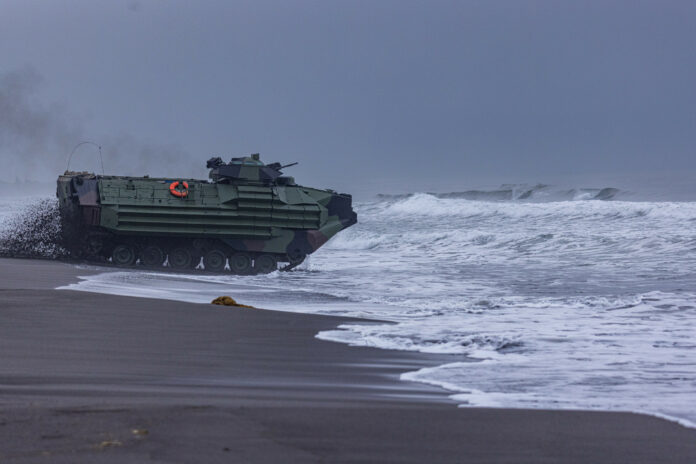An anti-landing drill scheduled for Thursday morning in southwestern Taiwan was the latest military exercise aimed at protecting the island’s “red beaches”—locations considered most vulnerable to China’s potential invasion force.
Xishu Beach, the site of the Taiwanese army’s live-fire drill, is near downtown Tainan, a coastal city of nearly 2 million people that faces the choppy waters of the Taiwan Strait, the strategic waterway—only 80 miles wide at its narrowest point—separating the old Cold War foes.
China’s Communist Party leaders claim Taiwan as part of Chinese territory, although the current government in Beijing has never governed there. On Tuesday, on the 130th anniversary of the late Chairman Mao Zedong’s death, Chinese leader Xi Jinping said unification of both sides of the strait “will surely” happen.
In recent years, China has stepped up its near-daily military maneuvers around the democratically ruled island in moves experts say are a rehearsal of things to come, although officials in Taipei and Washington believe an invasion isn’t imminent.
In the event of a full-scale cross-strait amphibious assault, Taiwan’s rugged terrain would restrict the number of beaches suitable for landing Chinese troops to fewer than 20. But cautious Taiwanese defense planners have identified close to two dozen of these red beaches.
Taiwanese forces have staged a variety of exercises this year to probe these beaches for weaknesses. In late November, amphibious assault vehicles rolled off a ship and onto a beach in the southern port city of Kaohsiung in a simulated attack.
Wu Tzu-li, an associate research fellow with Taiwan’s top military think tank, the Institute for National Defense and Security Research, said the regular drills yield valuable data on how features like slopes and beach heads can be put to good use, to fortify defenses or plan deployments of ground forces.
“The lessons of the Russo-Ukrainian War clearly demonstrate the importance of battlefield management,” Wu told Newsweek.
In addition to its own landing vehicles, Wu said, Taiwan will be considering the capabilities of the Chinese People’s Liberation Army, which has at its disposal certain platforms that its smaller neighbor does not—large hovercraft, for example.
In cases where it isn’t feasible to obtain equipment likely to be used in amphibious landings, Wu recommended Taiwan adopt mixed or augmented reality technology for future simulations.
The enemy’s potential route, their location, and their number must also be considered, he said.
Annabelle Chih/Getty Images
Some observers have called on Taiwan to spend more on its defense—an expenditure currently equal to 2.5 percent of its GDP—and gird its people for a worst-case scenario.
The United States, Taiwan’s main arms supplier and its strongest international backer for decades, has urged Taipei to acquire more weapons systems that would suit an asymmetric war against a more powerful enemy.
Taiwan has taken steps to beef up its defense capacity in recent years, including increasing by its compulsive military service for men from four months to one year, in addition to producing homemade submarines and military drones.
Although the U.S., like most countries, doesn’t recognize Taiwan diplomatically, it remains Taipei’s most important security guarantor. Washington’s long-running policy of “strategic ambiguity” leaves open the possibility of an American military response to a future PLA attack on the island.
To be sure, an invasion across the Taiwan Strait would be far from a cakewalk. Subject-matter experts believe Beijing would need to muster a force of over 1 million troops, as well as tens of millions of tons of supplies, in order to successfully seize—and occupy—Taiwan.
It would be an undertaking several times more challenging than the Normandy landings of 1944, a campaign that has yet to be repeated in modern warfare.
Besides Taiwan’s restrictive geography, other factors like weather and sea conditions also will play a part.
According to researcher Ian Easton’s 2017 book The Chinese Invasion Threat: Taiwan’s Defense and American Strategy in Asia, April and October may be the only suitable windows in which China can move large numbers of forces across the water.
The Chinese Foreign Ministry did not immediately respond to Newsweek‘s written request for comment.
Uncommon Knowledge
Newsweek is committed to challenging conventional wisdom and finding connections in the search for common ground.
Newsweek is committed to challenging conventional wisdom and finding connections in the search for common ground.


